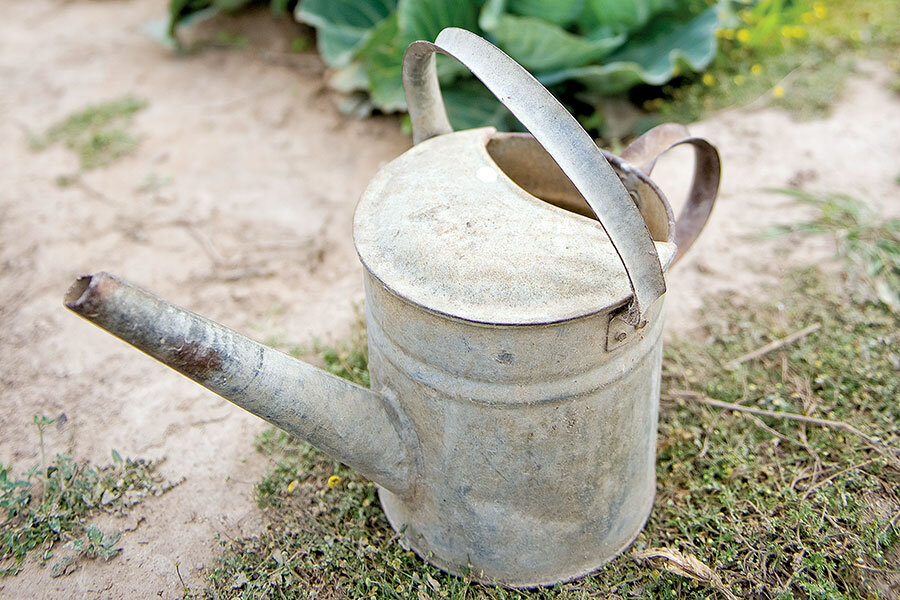Water-saving tips for your garden
Loading...
Drought-stricken California isn’t alone: Nearly every region of the United States has recently experienced water shortages, and at least 36 states anticipate serious shortages, even under nondrought conditions.
The average US family of four has a 400-gallon-a-day water habit, with about 35 percent of that used outdoors. The water-guzzling champion is the lawn, but flower beds and food gardens are less demanding only because they are smaller.
Conserving water in the yard begins with shrinking the lawn, then with using water-sipping plants. While most dry-condition Southwestern species don’t thrive in my Vermont garden, I still can be water-smart using New England natives. These trees, shrubs, vines, ground covers, and flowers are adapted to my soil and climate and will survive with normal rainfall. Most nurseries promote natives and xerophytes (drought-resistant plants).
The cardinal rule: Don’t water if it’s not needed. First, check soil moisture with your finger. If the soil feels damp, like a wrung-out sponge, about one inch down, there’s no need to water. And, whether using natives or nonnatives, follow the “right plant, right place” rule. Locating water-swigging willows in dry spots is, as the phrase goes, like spitting in the wind. Other water wise tips?
•Add trees and shrubs to create relief from sun and wind.
•Plant in beds to make irrigation efficient, but avoid raised beds, which dry out quickly.
•Grade beds to allow water to soak in rather than run off.
•Group plants with similar moisture needs.
•Reduce competition for water by weeding.
•Add compost and other organic matter to improve the moisture retention of the soil.
•Mulch, mulch, mulch: Add several inches of organic material, such as straw, shredded leaves, or bark, to shade and cool the soil.
•Plant new trees and shrubs in fall, when temperatures are cooler and rainfall is greater.
•Reduce fertilizing, especially in summer.
•Remove annuals that have finished blooming.
•Choose nonbreeezy days to water, and water before 10 a.m.
•Water deeply – brief sprinkling encourages shallow roots.
•Water the base of plants, not the leaves.
The tips above apply to growing vegetables as well as ornamentals. Here’s some more advice for food gardeners:
•Keep the soil pH in the 6.0-7.0 range.
•Start from seed whenever possible to encourage strong, deep root systems.
•Plant early-maturing varieties.
•Create basins around individual plants to trap water.
•Plant in blocks, rather than in rows.
•Harvest vegetables as soon as they are ripe, and remove plants when they’ve stopped producing.
Sprinklers are water-wasters; they’re only between 50 and 70 percent efficient. The types that emit large drops of water are better than those with misting spray heads, as less is lost through evaporation. Watering by hand can target individual plants, but few gardeners have the time or patience to water thoroughly that way.
Drip-irrigation systems that can be directed to individual plants limit evaporation and use far less water. They also involve a maze of tubing, emitters, pressure regulators, filters, and other fittings. They demand regular maintenance and often are costly.
An easier, cheaper alternative is a soaker hose, a porous rubber hose that oozes water. It’s simply laid on the soil surface, where it can remain all season (or it can be moved to different locations).
Soaker hoses aren’t perfect. They don’t work well on hills, and the maximum length for uniform soaking is 100 feet, so it’s best to buy them in 25- or 50-foot lengths. Experts recommend adding a timer and a pressure regulator.
You can make a soaker hose by drilling holes along the length of a garden hose, then capping its end. Easier still is a gallon milk jug or bucket with small holes punched in its bottom set next to a single plant. (The tree water bag is a commercial variation on this slow-release theme, ideal for new plantings.)
Last, take advantage of “free” water, beginning with rain. The runoff from a 1,000-square-foot roof is approximately 600 gallons for every inch of rainfall. (Make sure the catching container is covered to prevent breeding mosquitoes.)
While not recommended for vegetable gardens, grey water (household water from everything but toilets) can be used on ornamentals. Baths and kitchens require major replumbing to divert grey water, so most people settle for manually bailing tubs and catching shower water in a bucket. The water that would otherwise go down the drain as the water heats up for a bath or shower can be captured in a bucket and schlepped to the garden. If you can, avoid contaminating the water with soap or shampoo.
Recycling washing-machine water requires less replumbing but is more complicated than simply attaching a garden hose to your machine. Do-it-yourselfers should consult http://bit.ly/graygardenwater, as errors can lead to burning out the washer motor and other woes.






